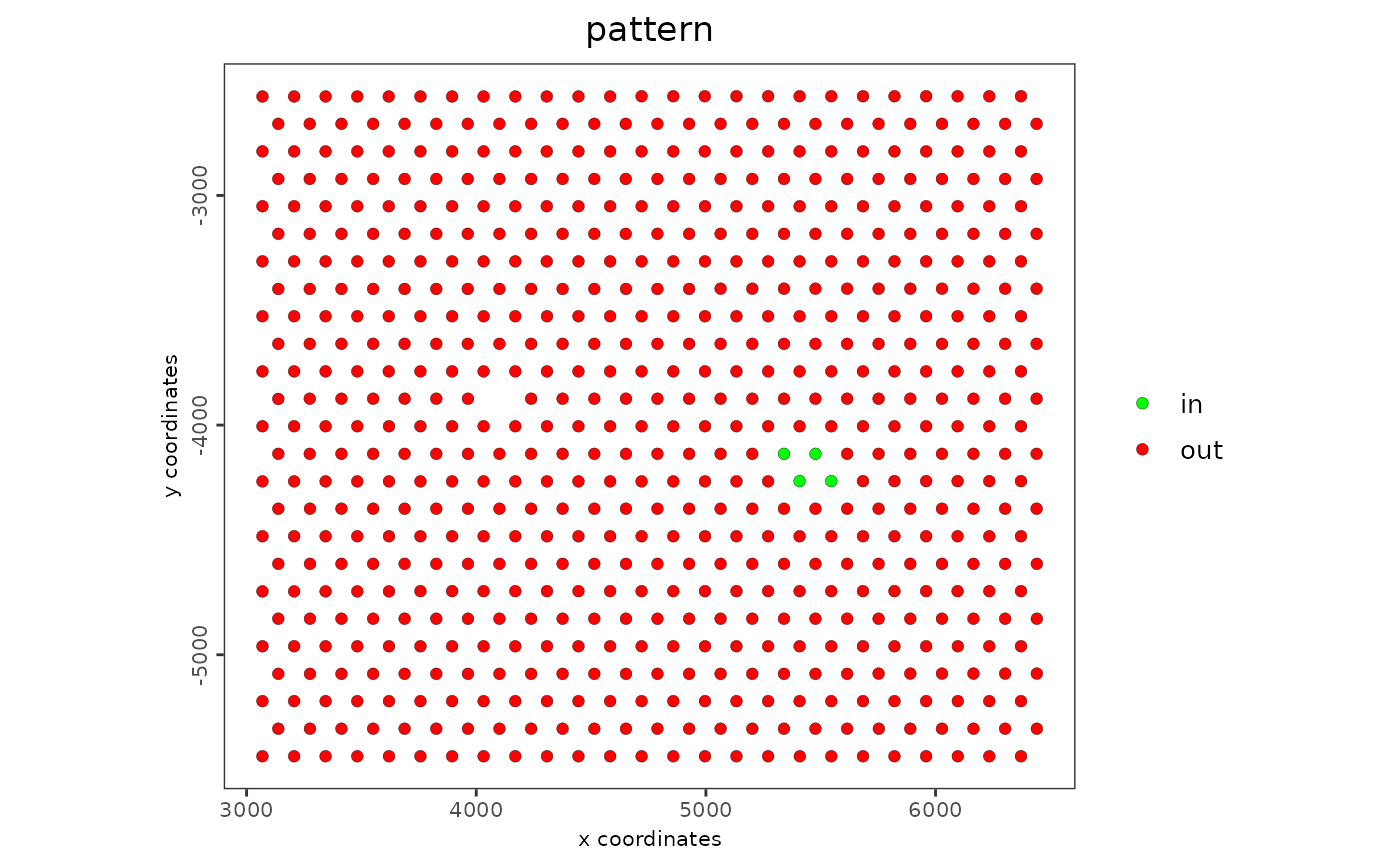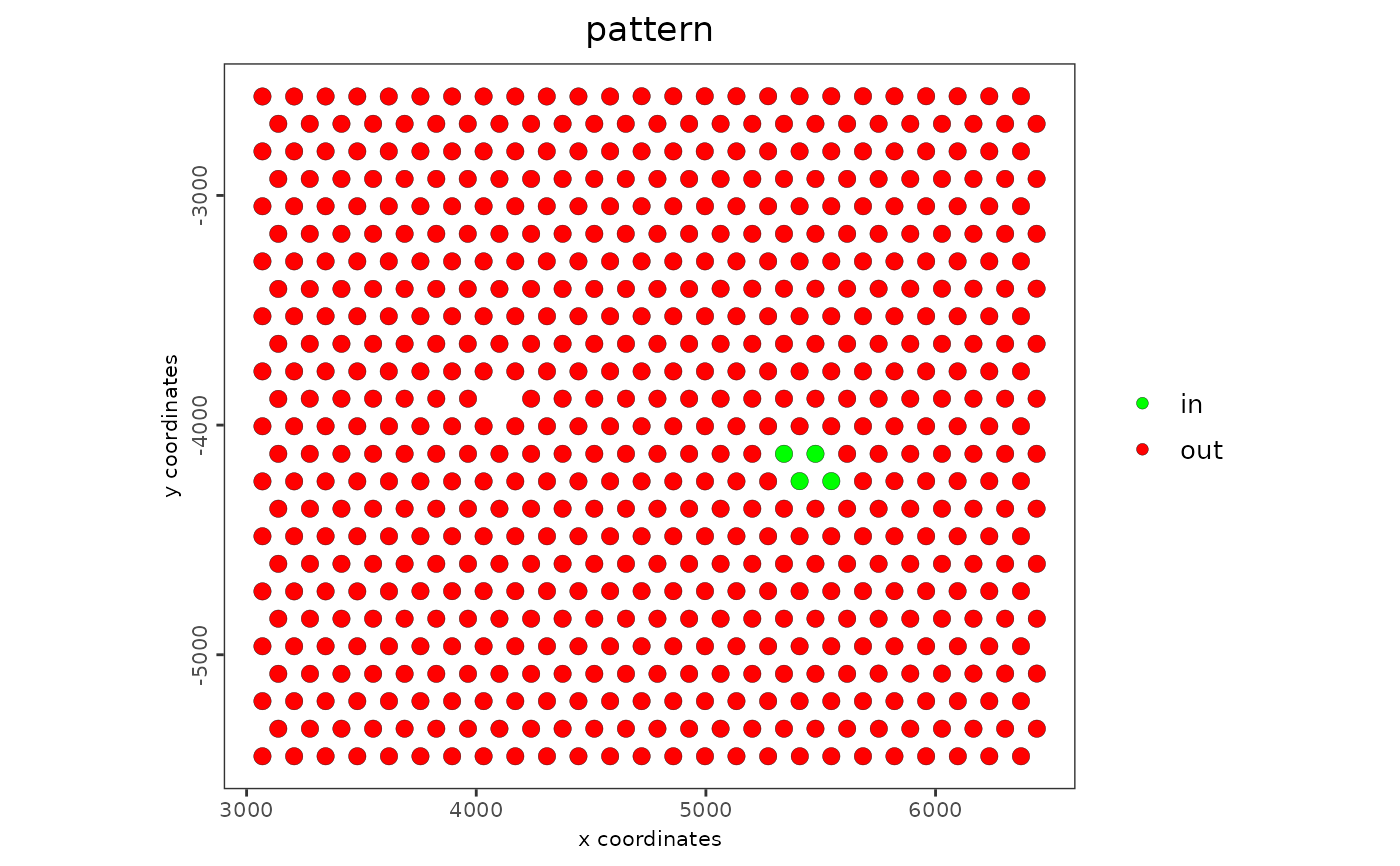Creates a known spatial pattern for selected genes one-by-one and runs the different spatial gene detection tests
runPatternSimulation(
gobject,
pattern_name = "pattern",
pattern_colors = c(`in` = "green", out = "red"),
pattern_cell_ids = NULL,
gene_names = NULL,
spatial_probs = c(0.5, 1),
reps = 2,
spatial_network_name = "kNN_network",
spat_methods = c("binSpect_single", "binSpect_multi", "spatialDE", "spark",
"silhouetteRank"),
spat_methods_params = list(NA, NA, NA, NA, NA),
spat_methods_names = c("binSpect_single", "binSpect_multi", "spatialDE", "spark",
"silhouetteRank"),
scalefactor = 6000,
save_plot = TRUE,
save_raw = TRUE,
save_norm = TRUE,
save_dir = "~",
max_col = 4,
height = 7,
width = 7,
run_simulations = TRUE,
...
)Arguments
- gobject
giotto object
- pattern_name
name of spatial pattern
- pattern_colors
2 color vector for the spatial pattern
- pattern_cell_ids
cell ids that make up the spatial pattern
- gene_names
selected genes
- spatial_probs
probabilities to test for a high expressing gene value to be part of the spatial pattern
- reps
number of random simulation repetitions
- spatial_network_name
which spatial network to use for binSpectSingle
- spat_methods
vector of spatial methods to test
- spat_methods_params
list of parameters list for each element in the vector of spatial methods to test
- spat_methods_names
name for each element in the vector of spatial elements to test
- scalefactor
library size scaling factor when re-normalizing dataset
- save_plot
save intermediate random simulation plots or not
- save_raw
save the raw expression matrix of the simulation
- save_norm
save the normalized expression matrix of the simulation
- save_dir
directory to save results to
- max_col
maximum number of columns for final plots
- height
height of final plots
- width
width of final plots
- run_simulations
run simulations (default = TRUE)
- ...
additional parameters for renormalization
Value
data.table with results
Examples
g <- GiottoData::loadGiottoMini("visium")
#> 1. read Giotto object
#> 2. read Giotto feature information
#> 3. read Giotto spatial information
#> 3.1 read Giotto spatial shape information
#> 3.2 read Giotto spatial centroid information
#> 3.3 read Giotto spatial overlap information
#> 4. read Giotto image information
#> python already initialized in this session
#> active environment : '/usr/bin/python3'
#> python version : 3.12
runPatternSimulation(
gobject = g, pattern_cell_ids = c(
"AAAGGGATGTAGCAAG-1",
"TCAAACAACCGCGTCG-1", "ACGATCATACATAGAG-1", "TATGCTCCCTACTTAC-1"
),
spatial_network_name = "spatial_network",
gene_names = c("Gna12", "Ccnd2")
)
 #> > raw already exists and will be replaced with new values
#> Setting expression [cell][rna] raw
#> first scale feats and then cells
#> > normalized already exists and will be replaced with new values
#> Setting expression [cell][rna] normalized
#> > scaled already exists and will be replaced with new values
#> Setting expression [cell][rna] scaled
#> calculating statistics for "normalized" expression
#> feat statistics has already been applied once; overwriting
#> cells statistics has already been applied once; overwriting
#> > raw already exists and will be replaced with new values
#> Setting expression [cell][rna] raw
#> first scale feats and then cells
#> > normalized already exists and will be replaced with new values
#> Setting expression [cell][rna] normalized
#> > scaled already exists and will be replaced with new values
#> Setting expression [cell][rna] scaled
#> calculating statistics for "normalized" expression
#> feat statistics has already been applied once; overwriting
#> cells statistics has already been applied once; overwriting
 #> start with 0.5
#> repetition = 1
#> > raw already exists and will be replaced with new values
#> Setting expression [cell][rna] raw
#> first scale feats and then cells
#> > normalized already exists and will be replaced with new values
#> Setting expression [cell][rna] normalized
#> > scaled already exists and will be replaced with new values
#> Setting expression [cell][rna] scaled
#> calculating statistics for "normalized" expression
#> feat statistics has already been applied once; overwriting
#> cells statistics has already been applied once; overwriting
#>
#> This is the single parameter version of binSpect
#>
#> 1. matrix binarization complete
#>
#> 2. spatial enrichment test completed
#> This is the multi parameter version of binSpect
#> Setting spatial network [cell] temp_knn_network
#> Run for k = 5
#>
#> This is the single parameter version of binSpect
#>
#> 1. matrix binarization complete
#>
#> 2. spatial enrichment test completed
#> Setting spatial network [cell] temp_knn_network
#> Run for k = 10
#>
#> This is the single parameter version of binSpect
#>
#> 1. matrix binarization complete
#>
#> 2. spatial enrichment test completed
#> Setting spatial network [cell] temp_knn_network
#> Run for k = 20
#>
#> This is the single parameter version of binSpect
#>
#> 1. matrix binarization complete
#>
#> 2. spatial enrichment test completed
#> Warning: SpatialDE python module is not installed:
#> install in the right environment or python path with:
#>
#> 'pip install spatialde'
#>
#> or from within R in the Giotto environment with:
#>
#> conda_path = reticulate::miniconda_path()
#> conda_full_path = paste0(conda_path,'/','bin/conda')
#> full_envname = paste0(conda_path,'/envs/giotto_env')
#> reticulate::py_install(
#> packages = c('NaiveDE', 'patsy', 'SpatialDE'),
#> envname = full_envname,
#> method = 'conda',
#> conda = conda_full_path,
#> pip = TRUE,
#> python_version = '3.6')
#> using 'SpatialDE' for spatial gene/pattern detection. If used in
#> published research, please cite:
#> Svensson, Valentine, Sarah A. Teichmann, and Oliver Stegle.
#> 'SpatialDE: Identification of Spatially Variable Genes.'
#> Nature Methods 15, no. 5 (May 2018): 343-46.
#> https://doi.org/10.1038/nmeth.4636.
#> Error in py_run_file_impl(file, local, convert): ModuleNotFoundError: No module named 'pandas'
#> Run `reticulate::py_last_error()` for details.
#> start with 0.5
#> repetition = 1
#> > raw already exists and will be replaced with new values
#> Setting expression [cell][rna] raw
#> first scale feats and then cells
#> > normalized already exists and will be replaced with new values
#> Setting expression [cell][rna] normalized
#> > scaled already exists and will be replaced with new values
#> Setting expression [cell][rna] scaled
#> calculating statistics for "normalized" expression
#> feat statistics has already been applied once; overwriting
#> cells statistics has already been applied once; overwriting
#>
#> This is the single parameter version of binSpect
#>
#> 1. matrix binarization complete
#>
#> 2. spatial enrichment test completed
#> This is the multi parameter version of binSpect
#> Setting spatial network [cell] temp_knn_network
#> Run for k = 5
#>
#> This is the single parameter version of binSpect
#>
#> 1. matrix binarization complete
#>
#> 2. spatial enrichment test completed
#> Setting spatial network [cell] temp_knn_network
#> Run for k = 10
#>
#> This is the single parameter version of binSpect
#>
#> 1. matrix binarization complete
#>
#> 2. spatial enrichment test completed
#> Setting spatial network [cell] temp_knn_network
#> Run for k = 20
#>
#> This is the single parameter version of binSpect
#>
#> 1. matrix binarization complete
#>
#> 2. spatial enrichment test completed
#> Warning: SpatialDE python module is not installed:
#> install in the right environment or python path with:
#>
#> 'pip install spatialde'
#>
#> or from within R in the Giotto environment with:
#>
#> conda_path = reticulate::miniconda_path()
#> conda_full_path = paste0(conda_path,'/','bin/conda')
#> full_envname = paste0(conda_path,'/envs/giotto_env')
#> reticulate::py_install(
#> packages = c('NaiveDE', 'patsy', 'SpatialDE'),
#> envname = full_envname,
#> method = 'conda',
#> conda = conda_full_path,
#> pip = TRUE,
#> python_version = '3.6')
#> using 'SpatialDE' for spatial gene/pattern detection. If used in
#> published research, please cite:
#> Svensson, Valentine, Sarah A. Teichmann, and Oliver Stegle.
#> 'SpatialDE: Identification of Spatially Variable Genes.'
#> Nature Methods 15, no. 5 (May 2018): 343-46.
#> https://doi.org/10.1038/nmeth.4636.
#> Error in py_run_file_impl(file, local, convert): ModuleNotFoundError: No module named 'pandas'
#> Run `reticulate::py_last_error()` for details.